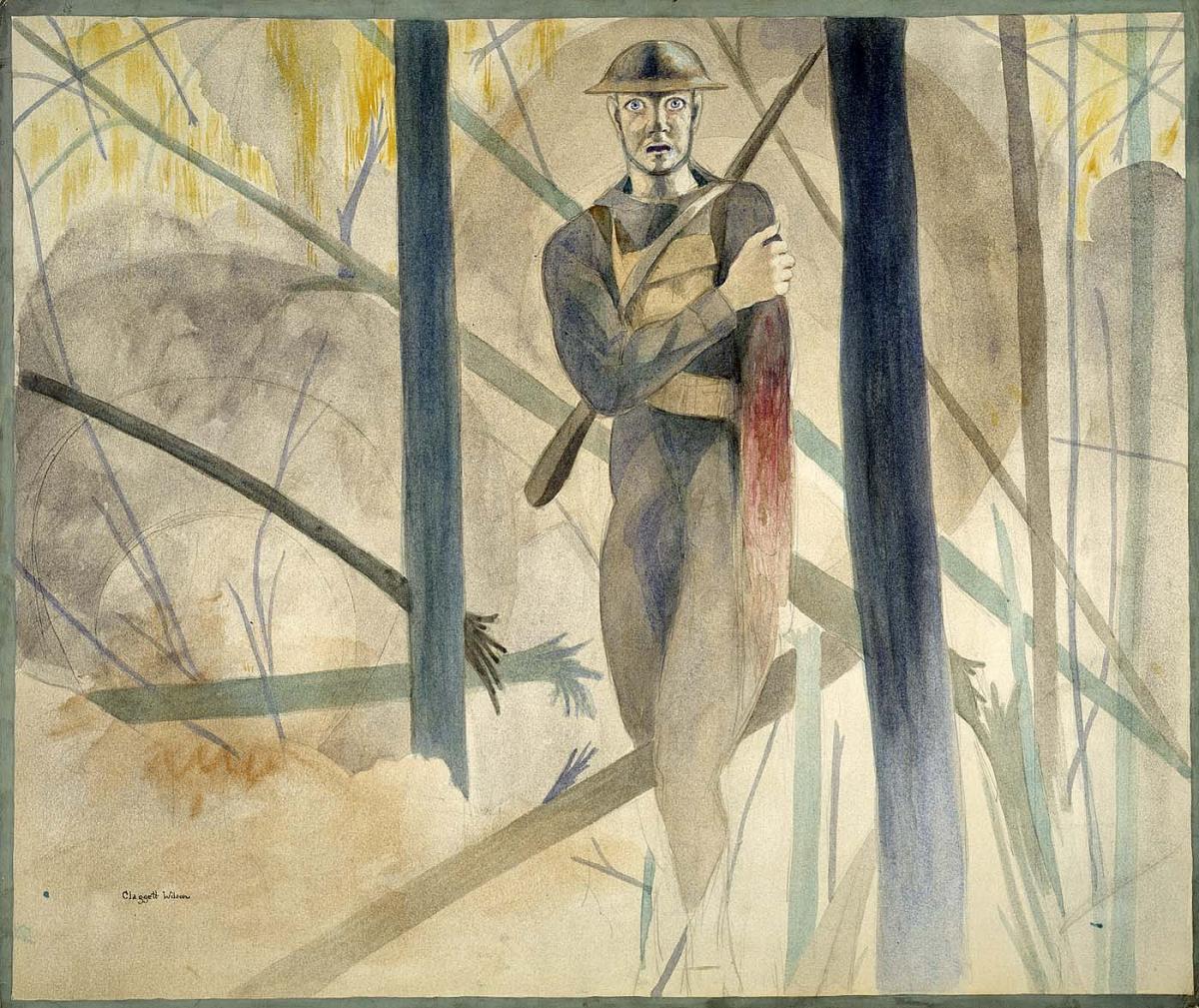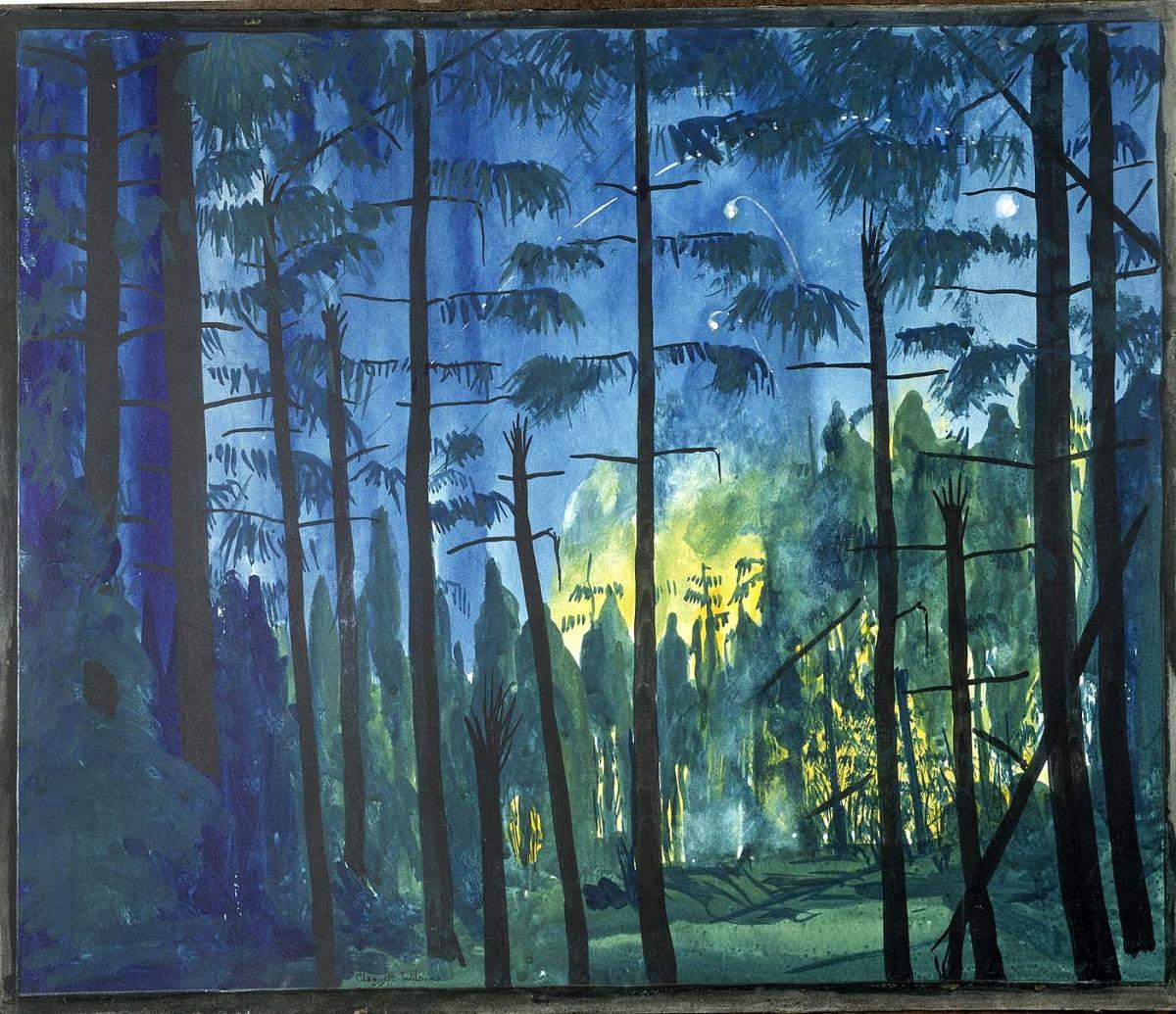Art can be a powerful record of experience. How does an artist convey the experience of war? What might we learn today from studying and caring for these works? Kate Maynor, a paper conservator at SAAM, and Ben Brands, veteran and military historian at the American Battle Monuments Commission, discuss artist Claggett Wilson’s watercolor paintings depicting his experiences as a combat marine in World War I.
Kelly Skeen: Who was Claggett Wilson?
Kate Maynor: Claggett Wilson was an academically trained artist and an art teacher who served in World War I. Wilson created a portfolio of watercolor paintings based on his experience. Through his art, he examined the damage that war inflicts on human minds and bodies and on nature. The paintings are rendered in a style that is both realistic and expressionistic.
The twenty-three paintings in Wilson’s war portfolio came into the Smithsonian American Art Museum’s collection in 1981. I became involved with Claggett Wilson’s watercolors when they needed to be assessed and treated for the 2016 exhibition titled “World War I and American Art” at the Pennsylvania Academy of Fine Arts.
Ben Brands: Claggett Wilson served as a Marine in World War I, when the United States sent two regiments of Marines overseas. It was the first time the Marines fought as kind of a second land army. The Marines were put into the 2nd Division of the Army and served throughout the war, specifically at Belleau Wood in France. On June 6, 1918, during one of the opening battles of the war for the Americans, more Marines were killed in that one afternoon than in the total previous existence of the Marine Corps since 1775. So, this was a searing experience for Marines like Wilson. He was wounded twice and gassed. Wilson never fully recovered from that experience, and he channeled his memories into the paintings that he drafted during and after the war.
I have an interesting connection with Wilson, which impacts the way I look at this art. When I was in the Army, I commanded a company in the 2nd Infantry Division, the same division that Wilson served in.
Wilson’s war paintings make visible and preserve his experiences in World War I. Ben, can you share more about World War I and its impact?
Ben: When we think about World War I today, it’s important to understand what a shock it was. When the war broke out in 1914, Europe had been at peace for over forty years since the Wars of German Unification. While there was this process of universal military service, there was simultaneously a feeling that Europe had evolved past its nature as constant warfare that marked most of its history.
The way World War I was conducted was also a shock. The way armies were organized made this war very different from what we see in preceding periods. Trench warfare, which Wilson depicts in several of his paintings, became the primary mode of operation in this war. Decisive battles lasted months and cost casualties numbering in the hundreds of thousands. The Meuse–Argonne offensive, which was America's portion of the 100 Days campaign that ended the war, lasted for forty-seven days, 1.2 million Americans participated in it, and over 26,000 Americans were killed.
Also, technology changed the nature of war in ways that made it horrific and impersonal, but still viscerally personal for the people it was inflicted on. Artillery had advanced to the stage where it became the number one killer. 60% of people killed in World War I were killed by artillery. In comparison, in the American Civil War, America's last major war before this, 20% of those killed were killed by artillery. Wilson illustrates the impact of this change with his depiction of the bursting shell in his painting Flower of Death--The Bursting of a Heavy Shell--Not as It Looks, but as It Feels and Sounds and Smells. It makes war kind of impersonal and random in a way.
All wars are terrible, but in some ways, World War I was uniquely terrible. I think the shock comes through in art in general from this period, but it specifically does for Claggett Wilson who experienced the war personally.
Kate, you conserve art so that audiences can continue to appreciate it for years to come. Can you tell us more about that process?
Kate: As art conservators, our work begins with examination. So, when approaching Wilson’s watercolors, I assessed characteristics and conditions of the paints and the paper. For example, as the colors faded, are they still soluble in water? How absorbent is the paper?
We use a variety of visual and technical means to determine the materials, techniques, and condition of artworks. It's important for us to distinguish between conditions that are stable versus those that are ongoing and may require some intervention. We document our examination and our treatments in permanent written and photographic records, so all this information is available for future caretakers.
We use different analytical instruments and techniques to further explore an artist’s materials or their methods. Flower of Death is very typical of the materials, techniques, and condition of all Wilson's paintings. Wilson used a variety of commercial illustration boards. His technique involves a graphite underdrawing with layers of watercolor washes, sometimes with additions of black ink, and even a bit of varnish.
Our conservation treatments are designed to stop or to slow down ongoing deterioration, repair damage, and sometimes restore aesthetics or functionality. Sometimes our treatments are obvious in before and after comparisons, and other times they are almost invisible.
After spending time with his paintings, what question would you ask Claggett Wilson?
Kate: The works in our collection are actually recreations, from memory, that the artist did because the original works he painted while stationed in Germany after the armistice were lost in transit back to the United States. I would like to ask him how he felt when those original works were lost. What motivated him to recreate them? What was the process of recreating the paintings like?
Ben: My question for him would be twofold. First, what do you get out of painting your wartime experience? What is your goal of painting them? How does this help you deal with and process your own experience? And then on the flip side of that, what do you want the viewers to take away? Because a viewer might not take away necessarily what Claggett Wilson thought.
Claggett Wilson’s paintings are not documentary records of war. What does art reveal that something like journalism or historical writing does not?
Ben: In many ways, war is an unreplicable event. The experience of being in battle and being exposed to the bursting of a heavy shell is something that cannot be conveyed in its full power. You could write paragraphs and paragraphs of dry text, try and describe it as a journalist or historian. But so much of what happens in wars is not just factual, but emotional and visceral. In some ways, art is much better to capture that. Even if it’s still a pale capture compared to the reality, it’s better positioned to capture that than dry text. And I say that as a guy who's spent my career writing dry texts to try and describe past military events. But my work at the American Battle Monuments Commission, and specifically my work with the Smithsonian American Art Museum over the last couple of years, has helped me understand how powerful art can be in better conveying the experience of war to people who weren't there.
This conversation represents a partnership between SAAM and the American Battle Monuments Commission, which commemorates the honor, service and sacrifice of America’s fallen in wars abroad. This discussion took place November 9, 2022, as part of SAAM’s Double Take program series, which brings experts from different disciplines into conversation about an object in SAAM’s collection. Kelly Skeen, interpretation specialist in SAAM’s Education department, was the host.
This story has been edited from a transcript of the program for clarity and length. Watch the program “Double Take: Preserving Portraits of War” on the museum’s YouTube channel.





















